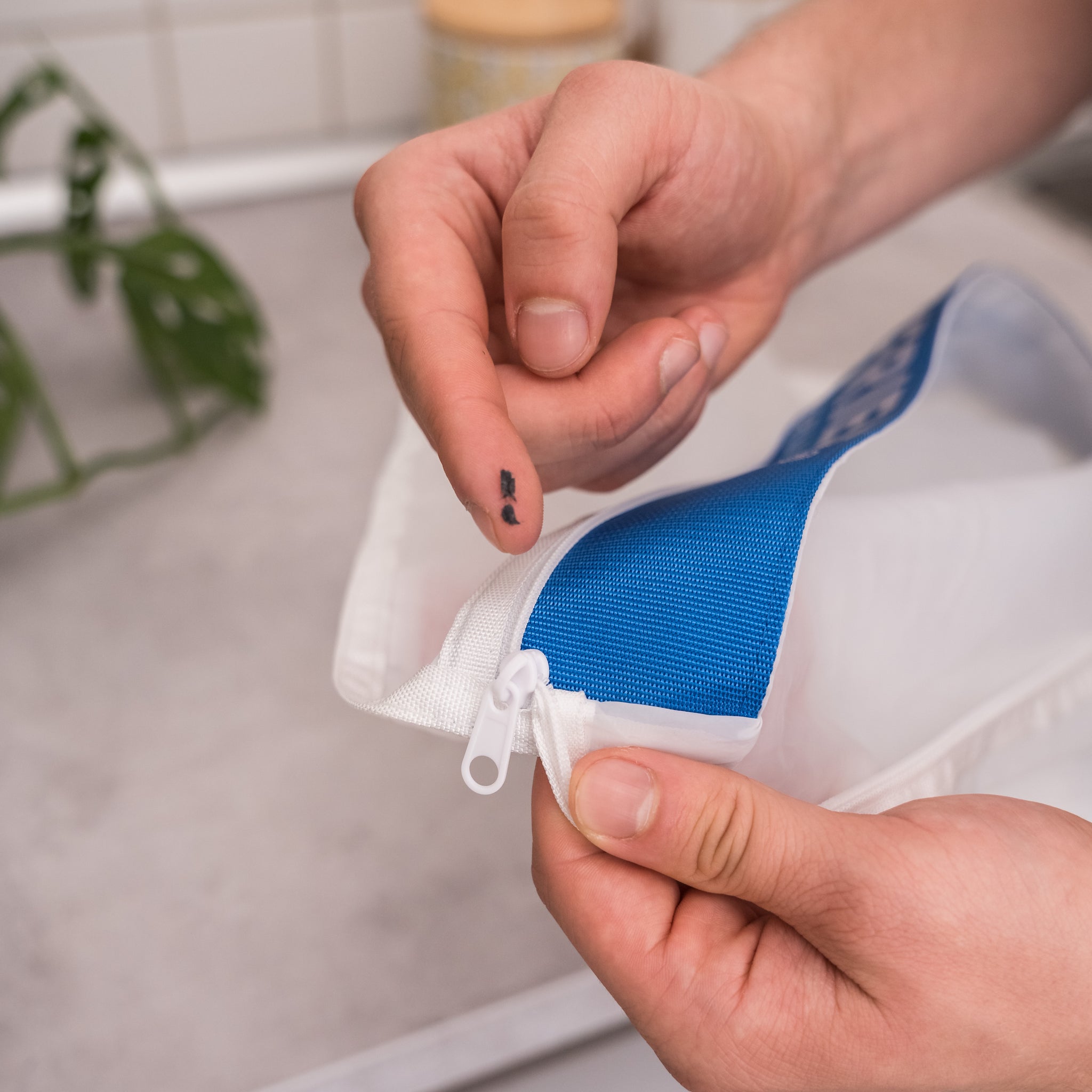Managing Microplastics When Washing Synthetic Fibres

We often talk about fabric here on our blog (it’s in our name – we have to!), but one of our driving missions as a company is to look beyond the fabric we sew with and learn more about the impact it has on people and the environment. One area of big concern for us is microplastics from fabric and clothing entering water systems during its wash cycle, and here we want to talk about what we can do to prevent it.
All manufactured fabrics have an impact on the environment, and as a result we lean towards natural fibres whenever possible. However, synthetic fibres can greatly extend the life of garments and are sometimes necessary for the best function of fabric. Some common uses include spandex for stretch, nylon for performance and durability, and polyester for strength. Whenever possible, we try to source recycled synthetics to help minimize the footprint of these fibres, like our recycled nylon swim fabrics and recycled polyester thread.
We hope the garments you create with our synthetic fabrics last years and years, helping eliminate the amount of synthetic fibres consumed overall. But did you know that synthetic fabrics can still harm the environment even while they're being worn? Here's a quick primer on how – and a dive into the deep topic of microplastics in the textile industry.
What are microplastics?

If you’ve never heard the term before, microplastics are small pieces of plastic that shed from clothing, decorations, toys, health and beauty products, and more. They're a largely unavoidable side-effect of our way of life, as we depend upon plastics for the manufacturing of many common goods.
Focusing on the textile industry specifically, more than 60% of clothing is made with synthetic fibers, such as acrylic, nylon, and polyester. Because polyester is durable and inexpensive, it quickly took over as the go-to option for the mass production of clothing in the 1960s, and has only grown more and more prevalent.
Unfortunately, this means a majority of our wardrobes end up shedding microplastics over the course of their lifetime, especially when put through the laundry. The agitation of the washing machine breaks fibres loose, and they drain out with the water at the end of the cycle, mixing with other waste water before being treated and released back into oceans, lakes, and other large bodies of water. As a result, the ocean has been flooded with microplastics, which are then consumed by ocean life. These microplastics can even end up back on our plates in our seafood! In the last 10 years alone, over 2 million tons of microplastics have been released from our laundry into the world around us.
What can we do to avoid this?

As with many of our current environmental issues, the spread of microplastics can feel like an uphill battle. However, change always starts on a small scale, and there are some ways to prevent the shedding of microplastics in your own life. One way is to try and use natural fibres whenever possible. Fabrics made from cotton, linen, wool, silk, viscose, and rayon will break down naturally and do not cause harm when they shed from natural wear over time. At Core Fabrics, we do our best to make it possible for you to make projects that are completely biodegradable, including cotton thread and 100% cotton “Compost Me” labels.
When synthetics are unavoidable, however, the best move is to create or purchase garments that will last as long as possible. However, these garments still need to be washed, and during the washing synthetic fibres are sure to shed, draining into the wastewater system and eventually into the ocean.
One of the hardest parts about managing microplastics is their size – they are, well, micro, which makes them very difficult to collect or even notice on a domestic level. With this in mind, companies like Guppyfriend have found ways to help collect microplastics before they have a chance to drain into the water, with products like filters for home washing machines or the more accessible Guppyfriend Wash Bags. We're excited to begin carrying these here at Core Fabrics – using laundry filters for synthetic fabrics has been shown to remove up to 95% of microplastics released in the laundering process!
Guppyfriend Wash Bag

When you wash synthetic fabrics, place them in your Guppyfriend Wash bag before throwing them in the washer. The bag catches any loose fibres and contains them like a dryer lint trap – the microplastics can then be disposed of outside of your water system.
The Guppyfriend Wash Bag is made of polyamide 6.6, a material that consists of stick-like fibres which do not shed or break off in the wash. Although it may seem like a drop in the bucket vis-a-vis solving the grander microplastic issue, the Guppyfriend wash bag also serves as a reminder to be thoughtful about our consumption habits and washing rituals. It comes in plastic-free packaging, too!
Microplastics are just one facet of the deep, complex issues we face in the textile industry, and like many other industry issues come with an equally complex group of possible solutions. But within the sewing community, we're familiar with making thoughtful, individual choices in the face of the consumer driven fast-fashion industry, and we believe that even small changes like this in our personal routines have an important and lasting impact.

